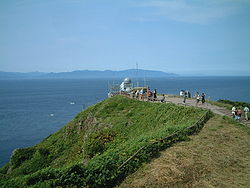Sotogahama, Aomori
|
Sotogahama 外ヶ浜町 |
|||
|---|---|---|---|
| Town | |||

Cape Tappi, northernmost point of Tsugaru Peninsula
|
|||
|
|||
 Location of Sotagahama in Aomori Prefecture |
|||
| Coordinates: 41°02′37″N 140°37′58″E / 41.04361°N 140.63278°ECoordinates: 41°02′37″N 140°37′58″E / 41.04361°N 140.63278°E | |||
| Country | Japan | ||
| Region | Tōhoku | ||
| Prefecture | Aomori Prefecture | ||
| District | Higashitsugaru | ||
| Area | |||
| • Total | 230.29 km2 (88.92 sq mi) | ||
| Population (September 2015) | |||
| • Total | 6,012 | ||
| • Density | 26.1/km2 (68/sq mi) | ||
| Time zone | Japan Standard Time (UTC+9) | ||
| City symbols | |||
| - Tree | Pine | ||
| - Flower | Hydrangea | ||
| - Bird | Common gull | ||
| Phone number | 0174-31-1111 | ||
| Address |
Kanita, Takadoya 44-2, Sotogahama-machi, Higashitsugaru-gun, Aomori-ken 030-1393 |
||
| Website | Official website | ||
Sotogahama (外ヶ浜町 Sotogahama-machi?) is a town located in Higashitsugaru District of northwestern Aomori Prefecture in the Tōhoku region of northern Japan. As of September 2015, the town had an estimated population of 6,012 and a population density of 26.1 persons per km2. Its total area was 230.29 square kilometres (88.92 sq mi).
Sotogahama occupies the eastern coastline of Tsugaru Peninsula, facing the Tsugaru Strait and the inlet to Mutsu Bay. The town has a cold maritime climate characterized by cool short summers and long cold winters with heavy snowfall. Much of the town is within the limits of the Tsugaru Quasi-National Park.
The Tsugaru Peninsula has been inhabited since Japanese Paleolithic times, and some of the world's oldest pottery has been discovered at the Odai Yamamoto I site. The area around Sotogahama was controlled by the Nambu clan of Morioka Domain during the Edo period. During the cadastral reform of 1889, Minmaya, Kanita and Tairadate villages were separated from Imabetsu. On March 28, 2005, these three municipalities merged to form the new town of Sotogahama. Minmaya is a geographically discontinuous enclave from the town's center in Kanita.
...
Wikipedia



